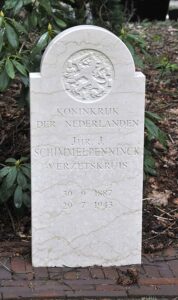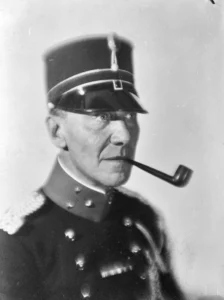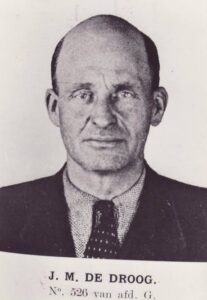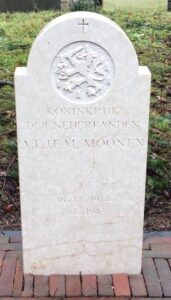Heel van, Fritjof Dudok, born 19-04-1918 born in Semarang,  NOI. Nieuw-Oost-Indië, the son of Sebastien Abraham Corneille Dudok van Heel and Johanna Maria, born Siebers. Fridjof had three brothers, Abraham Everardus (1915), Thorvald (1921) and Sebastien (Bas) Abraham Corneille (1925) and a sister Amunda (Mum) Baldine (1926). His father was administrator of a sugar factory near Kendal, west of Semarang. The family returned to Europe after the stock market crash of 1929 and settled in Bussum in 1932.
NOI. Nieuw-Oost-Indië, the son of Sebastien Abraham Corneille Dudok van Heel and Johanna Maria, born Siebers. Fridjof had three brothers, Abraham Everardus (1915), Thorvald (1921) and Sebastien (Bas) Abraham Corneille (1925) and a sister Amunda (Mum) Baldine (1926). His father was administrator of a sugar factory near Kendal, west of Semarang. The family returned to Europe after the stock market crash of 1929 and settled in Bussum in 1932.
Fridjof was born in the Dutch East Indies. From 1816 until its transfer in 1949, the Dutch East Indies was the official name used for the Dutch colony that eventually included present-day Indonesia. The foundation for the Dutch East Indies colony was laid by the Dutch East India Company (VOC) from 1602 onwards. In 1795, the VOC was taken over by the Dutch state. In the nineteenth and twentieth centuries, the Dutch colonial army conquered the vast majority of what eventually became known as Indonesia.
Fitjof’s father was an administrator of a sugar factory near Kendal. In 1929 the family returned to Europe and settled in Bussum. Dudok van Heel attended the HBS at the Christian Lyceum  there. In October 1938 he was called up for military service. He was placed with the 1st Regiment of Hussars
there. In October 1938 he was called up for military service. He was placed with the 1st Regiment of Hussars  in Amersfoort. During the May days of 1940 his regiment was involved in fighting around the Grebbeberg
in Amersfoort. During the May days of 1940 his regiment was involved in fighting around the Grebbeberg 
 near Rhenen. More than 400 soldiers buried here died in the immediate vicinity during the Battle of Grebbeberg.
near Rhenen. More than 400 soldiers buried here died in the immediate vicinity during the Battle of Grebbeberg.
After the capitulation, Dudok van Heel found work as a volunteer at the Suikerfabriek Holland in Halfweg. He also became involved in the resistance group that emerged around Jonkheer Johan Schimmelpenninck.

 Schimmelpenninck was arrested at home on 13-11-1941. He was imprisoned in the Scheveningen prison. During the interrogations by the Sicherheitsdienst (SD),
Schimmelpenninck was arrested at home on 13-11-1941. He was imprisoned in the Scheveningen prison. During the interrogations by the Sicherheitsdienst (SD), ![]() during which ‘regulated’ physical violence was used, Schimmelpennick did not say a word. On 06-11-1942 he was transported to Camp Amersfoort. On 18-01-1943 he ended up in Camp Vught
during which ‘regulated’ physical violence was used, Schimmelpennick did not say a word. On 06-11-1942 he was transported to Camp Amersfoort. On 18-01-1943 he ended up in Camp Vught  because of the evacuation of Camp Amersfoort. He was registered as Schutzhäftling 1988. Because of the Second OD trial he was transferred to Camp Haaren on 11-03-1943. On 27-04-1943 he was sentenced to death by the Wehrmachtjustiz. He was shot on 29-07-1943, age 55, on the Leusderheide,
because of the evacuation of Camp Amersfoort. He was registered as Schutzhäftling 1988. Because of the Second OD trial he was transferred to Camp Haaren on 11-03-1943. On 27-04-1943 he was sentenced to death by the Wehrmachtjustiz. He was shot on 29-07-1943, age 55, on the Leusderheide,  together with sixteen of his fellow resistance fighters.
together with sixteen of his fellow resistance fighters.
That group eventually merged into the Ordedienst (OD). ![]() Dudok van Heel was also connected to the Ordedienst through his fiancée Bé der Kinderen. Her stepfather Peter Versteegh
Dudok van Heel was also connected to the Ordedienst through his fiancée Bé der Kinderen. Her stepfather Peter Versteegh  was chief of staff of the OD. In August and September 1941, he had delivered messages on behalf of Versteegh several times.
was chief of staff of the OD. In August and September 1941, he had delivered messages on behalf of Versteegh several times.
At the Ordedienst, Dudok van Heel was a liaison officer. He was in contact with OD departments in Friesland, Limburg and Overijssel. After the arrest of a large part of the OD top in the second half of 1941 and early 1942, including Peter Versteegh, Dudok van Heel tried to keep the organization afloat together with Christiaan “Chris” Navis 
 from March 1942. Dudok van Heel maintained contacts between the national top and the various departments.
from March 1942. Dudok van Heel maintained contacts between the national top and the various departments.
Around June 1942, Dudok van Heel received a message from a subordinate Cor van der Put that the OD department in Aerdenhout was in contact with two secret agents. In fact, these were SD employees, namely NSB er Antonie Berends  and Johannes Mattheus (Johnny) de Droog.
and Johannes Mattheus (Johnny) de Droog.  one of the most notorious V-Men and as such responsible for the arrest of hundreds of resistance fighters.
one of the most notorious V-Men and as such responsible for the arrest of hundreds of resistance fighters.
Antonie Berends was sentenced to life in October 1948, in 1958 he was pardoned and was ”put to years”. (The current TBS) He was finally released in December 1960. In the year 1967 he emigrated with his family to South Africa, where, like his father in Deventer, he worked as a fruit trader.He died on 27-09-1971 in Randburg (South Africa) of a heart attack. He was 64 years old at the time.
Dudok van Heel met the two men several times. On 14-07-1942, a meeting was planned between De Droog and two members of the Amsterdam OD top, namely Chris Bührmann  and T. van der Ploeg.
and T. van der Ploeg.  The two Amsterdammers were suspicious and ultimately did not show up. That same evening, a whole group of OD employees were arrested, including Dudok van Heel and his employee Cor van der Put. During the interrogations, Van der Put quickly broke down and gave away a lot of valuable information. Dudok van Heel spent three months in solitary confinement in the so-called Oranjehotel in Scheveningen.
The two Amsterdammers were suspicious and ultimately did not show up. That same evening, a whole group of OD employees were arrested, including Dudok van Heel and his employee Cor van der Put. During the interrogations, Van der Put quickly broke down and gave away a lot of valuable information. Dudok van Heel spent three months in solitary confinement in the so-called Oranjehotel in Scheveningen. 
 From 07-11-1942 to 18-01-1943 he was interned in Camp Amersfoort and then until 12-03-1943 in Camp Vught.
From 07-11-1942 to 18-01-1943 he was interned in Camp Amersfoort and then until 12-03-1943 in Camp Vught.
On 15-03-1943 the Second OD trial began in Utrecht, in which Dudok van Heel was accused with 99 others. Twenty-one OD members were sentenced to death, four of whom were later pardoned. On 29-078-1943 sixteen men, including Dudok van Heel, age 35, were shot on the Leusderheide. Adriën Lambert Jacques Emile Marie Moonen’s 
 execution did not follow until a week later due to illness. Dudok van Heel is buried in the Old Cemetery of Naarden. Dudok van Heel was not the only member of the family who was active in the resistance. People in hiding stayed at his parents’ home. His sister Mum was a courier for the Dutch Secret Service.
execution did not follow until a week later due to illness. Dudok van Heel is buried in the Old Cemetery of Naarden. Dudok van Heel was not the only member of the family who was active in the resistance. People in hiding stayed at his parents’ home. His sister Mum was a courier for the Dutch Secret Service.

















Leave a Reply